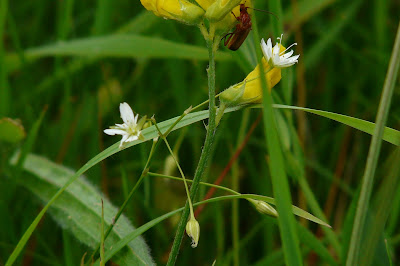If this rain/wind stops one day, I will get back and keepan eye on the Sea Aster. and its visitors.
Sea Aster, Aster tripolium

The Sea Aster is in good company there. Marsh Woundwort, Ox-eye Daisies, Dandelions, and Alexanders among others down there. All these do not mind standing in a little salt water with their feet.
Marsh Woundwort, Stachys palustris


The flowers clambering higher and higher against the wall.

A small tree or bush which had either started inside the wall, on down below, showed a parasite among its branches; the
Sea Bindweed. Calystega soldanella
 I love the white stripes which run from edge to the heart of the trumpet. This, to guide the pollinator to find the way.
I love the white stripes which run from edge to the heart of the trumpet. This, to guide the pollinator to find the way.The Great Willowherb, Epilopium hirsutum
 Mind you, this one is growing on the bank and not inside the wall.
Mind you, this one is growing on the bank and not inside the wall.And in the hedgerow near my home, I spotted these beautiful Violets. Some of the flowers were white, the others very pale blue, or as my book describes them as pale milky blue.

And back home:
The White Clover, Trifolium repense, keeps on flowering,

 Although Bindweed is a nasty parasitic plant, strangling others, I have learned a lot this year related to these perennials. Which is their association with Moths. First of all, that the glorious little Plume Moth depends on it and that the Bindweed relies on the Hawkmoths to pollinate. Not that I see any since the flowers have opened! It is mostly Bees which I see enter the flowers. Mind you, with the brief Sun rays and dark clouds recently, getting the flowers pollinated must be a race in itself for the plant, as the flowers do not always get enough light to keep them open during the day.
Although Bindweed is a nasty parasitic plant, strangling others, I have learned a lot this year related to these perennials. Which is their association with Moths. First of all, that the glorious little Plume Moth depends on it and that the Bindweed relies on the Hawkmoths to pollinate. Not that I see any since the flowers have opened! It is mostly Bees which I see enter the flowers. Mind you, with the brief Sun rays and dark clouds recently, getting the flowers pollinated must be a race in itself for the plant, as the flowers do not always get enough light to keep them open during the day.Zoe Devlin of Wildflowers of Ireland tells us that Bindweed is capable of growing full circle in a mere two hours!
At the moment it is attacking my beautiful Fennel, and the weather does not really let me get outside to rescue it.
And Comon Bird'sfoot Trefoil, Lotus corniculatus








































